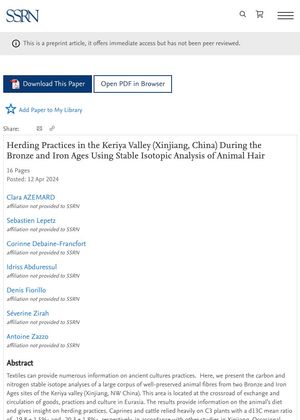Herding Practices in the Keriya Valley (Xinjiang, China) During the Bronze and Iron Ages Using Stable Isotopic Analysis of Animal Hair
January 2024

TLDR Ancient herders in the Keriya Valley fed their animals mainly C3 plants, with some C4 plant feeding possibly due to herd movement or seasonal changes.
The study used carbon and nitrogen stable isotope analyses of well-preserved animal fibers from two Bronze and Iron Ages sites in the Keriya valley, Xinjiang, NW China, to gain insights into ancient herding practices. The results showed that caprines and cattle heavily relied on C3 plants, with a d13C mean ratio of -19.8 ± 1.5‰ and -20.3 ± 1.8‰, respectively, consistent with other studies in Xinjiang. Occasional small C4 plants intake was also observed for caprines, possibly due to herd mobility or seasonal availability of local vegetation. Two Iron Age individuals, a camel and a cattle, showed a high C4 plants intake, which is unusual in this context, suggesting specific herding practices with millet foddering.